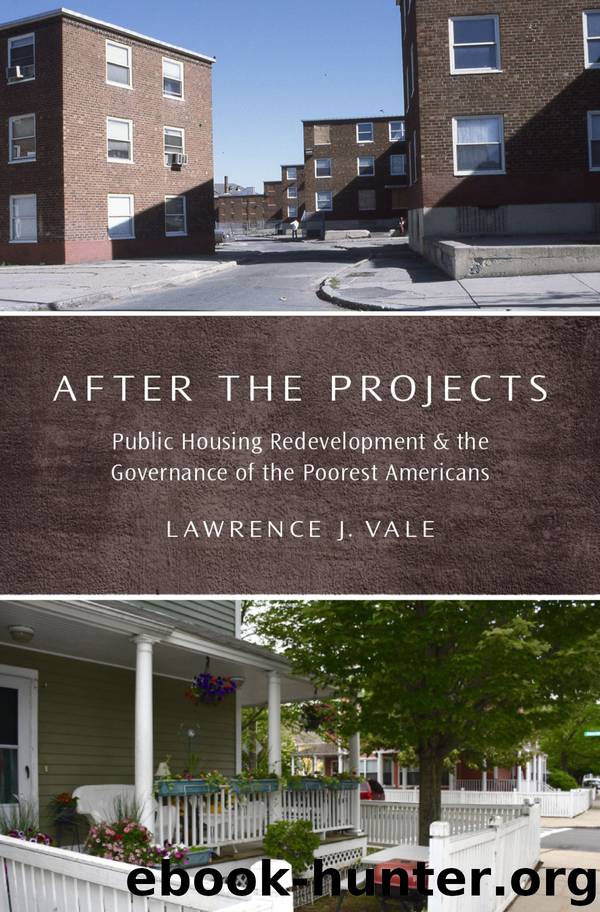After the Projects by Lawrence J. Vale

Author:Lawrence J. Vale
Language: eng
Format: epub
Publisher: Oxford University Press
Published: 2019-03-16T16:00:00+00:00
The Rise of Connie Chambers
The Connie Chambers Homes project, designed by the firm of Edson and Goldblatt, opened in the fall of 1967, just as the nearby downtown demolition ramped up. Named in memory of the former THA executive director who had died in 1965, the THA promised to give priority to those displaced from the urban renewal area. With two hundred new units becoming available, plus additional vacancies at the adjacent La Reforma, the resource at first seemed to be an appealing way for the 161 families and 120 individuals forced out of the Pueblo Center Redevelopment area to find new homes that were little more than a ten-minute walk from the razed parts of the barrio. By August 1967, sixty-six families from the urban renewal zone had applied for residence in what they usually called “New Reforma,” but soon became known as “the projects,” or “The PJays.” THA executive director Paul McCoy conceded that “not all families from the urban renewal area will qualify for residence in the housing project” but insisted that “we will have room for all those who do qualify.” Once again, the availability of public housing depended on what it meant to “qualify.” On the surface, the THA framed qualification around issues of residency and income. Households needed to have lived in Arizona for a year and within Pima County for at least six months, and they needed to have incomes lower than $3,000 unless they were supporting an unusually large number of children. Rents, which included utilities, varied from $28 to $78 per month, depending on family size. Tucson’s urban renewal staff expected “public housing to be “a major relocation resource,” and estimated that fully 40 percent of the “site occupants” would go there. To the surprise of many, however, only thirty-six families from the barrios razed to build the community center or the new public housing itself actually moved into either Connie Chambers or La Reforma by 1970.29
The housing authority did not retain records of these early tenants, but the Final Relocation Report issued by Tucson’s redevelopment agency coupled with various newspaper accounts and oral histories provide some sense of the variety of reasons why public housing officials resisted some tenants and some tenants resisted public housing. First off, for 120 lodgers and other single individuals purged from the barrio, “family” public housing simply was, by definition, not a viable alternative. Many larger households presumably failed to meet income or residency requirements. Although public housing rents sometimes compared favorably to what was available elsewhere in the barrio, a survey of displaced households conducted by the Tucson Redevelopment Agency in 1965 had found that “the average monthly income of the non-white residents was less than $100 per month,” suggesting that public housing rents could be out of reach, especially for larger families.30
The public housing option simply held no appeal for many people, either because its social environment seemed both isolating and socially disruptive, or because its design bore little relation to preferred modes of living.
Download
This site does not store any files on its server. We only index and link to content provided by other sites. Please contact the content providers to delete copyright contents if any and email us, we'll remove relevant links or contents immediately.
| General | Discrimination & Racism |
Nudge - Improving Decisions about Health, Wealth, and Happiness by Thaler Sunstein(6633)
iGen by Jean M. Twenge(4702)
The Fire Next Time by James Baldwin(4342)
Adulting by Kelly Williams Brown(3670)
The Sports Rules Book by Human Kinetics(3588)
The Hacking of the American Mind by Robert H. Lustig(3580)
The Ethical Slut by Janet W. Hardy(3502)
Captivate by Vanessa Van Edwards(3297)
Mummy Knew by Lisa James(3166)
In a Sunburned Country by Bill Bryson(2947)
Ants Among Elephants by Sujatha Gidla(2924)
The Worm at the Core by Sheldon Solomon(2917)
Suicide: A Study in Sociology by Emile Durkheim(2609)
The Slow Fix: Solve Problems, Work Smarter, and Live Better In a World Addicted to Speed by Carl Honore(2574)
Humans of New York by Brandon Stanton(2379)
Handbook of Forensic Sociology and Psychology by Stephen J. Morewitz & Mark L. Goldstein(2376)
Blackwell Companion to Sociology, The by Judith R. Blau(2318)
The Happy Hooker by Xaviera Hollander(2274)
Outliers by Malcolm Gladwell(2257)
